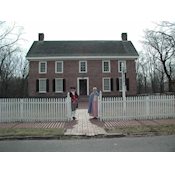Old Dutch Parsonage & Wallace House

The Old Dutch Parsonage, a two and one half story brick Georgian building was constructed in 1751 for the Reverend John Frelinghuysen, with funds from three Dutch Reformed churches in the Raritan Valley. He was succeeded by the Rev. Jacob Hardenbergh played an important part in the American Revolution, helping to ease tensions between the American army and local inhabitants during the Middlebrook Cantonment. The Reverend sold 95 acres of land and a small farmhouse to John Wallace, a Philadelphia fabric importer and merchant. Between 1775 and 1776, Wallace purchased an additional 12 acres of land and built an eight-room Georgian style mansion adjoining part of the existing farmhouse. It was the largest house built in New Jersey during the Revolutionary War. Naming his estate "Hope Farm", the house remains one of the best and most original examples of Georgian architecture in New Jersey. In the winter of 1778, General George Washington's Continental Army encamped at Middlebrook, just 3 miles form Hope Farm. The Old Dutch Parsonage remained a pastor's residence until 1810, when the church was sold. In 1907, the Central Railroad purchased the property and slated the house for demolition. Fortunately, the Parsonage was saved by the interested persons who moved it to its present location in 1913. The State of New Jersey acquired the property in 1947, opening it to the public. It was listed on the New Jersey Historic Register and then the National Register of Historic Places in 1970.
Advertisements
